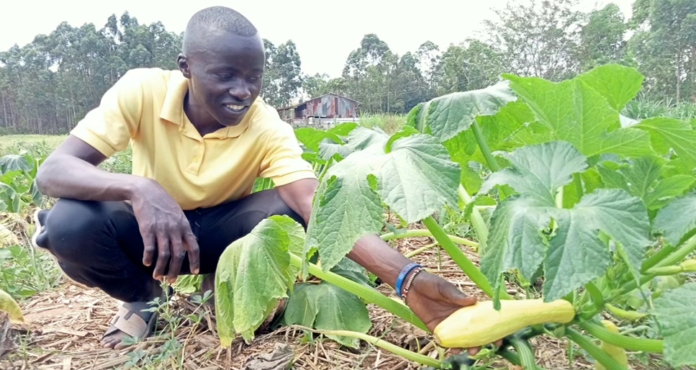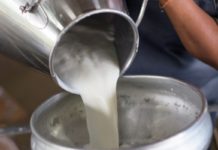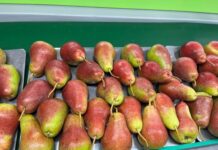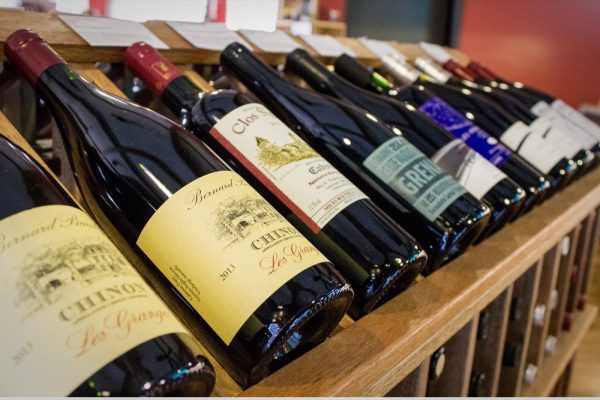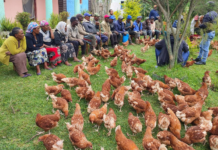In Mumias, Western Kenya, sustainable crop-growing methods are gaining traction, thanks to video animations by Scientific Animations Without Borders (SAWBO), a one-step educational system from global experts to end users, equipping farmers with simple practices to enhance their farm yields.
One of the methods featured in the video animations is preparing compost survival gardening, implemented by Matawa Demonstration Farm with support from Global Youth Groove (GYG), a SAWBO collaborator.
The farm which is about five kilometers from Mumias Town is situated on nine acres of land and has since turned into a community learning center for sustainable agriculture.
Paul Lutomia, the farm supervisor says: “We collect all the waste from animals and plants, turn it into manure, and then use it for crop production.”
The farm is expected to harvest about eight tons of compost manure that they have prepared with the use of biodegradable materials collected on the farm mixed with animal waste.
“After watching the SAWBO video on preparing compost survival gardening, we realized that we have more than enough materials on this farm already,” said Livingstone Okhasia, who also manages the farm.
Livingstone and Paul and other farm employees are determined to make sure that the farm maximizes all the resources available to produce healthy food.
Raised planting beds
The raised bed planting SAWBO video has also been impactful. Vegetable production is like water to fish for Paul, who has over 35 years of experience as a vegetable farmer. On the farm, he has embraced a raised bed land preparation system where most African leafy vegetables are grown besides exotic ones.
“The raised bed system is the best approach in preparing land for better yields, especially for vegetables.” He then showed me the bed he had made, ready to plant.
The 10 plots of 2 X 9 meter beds combined have a capacity to produce 100 kilograms of food per week.
“We raise the fine soil up to one and a half feet high for water retention and separate a bed from each other by a trench, which also serves as a walkway,” explains Paul.
“You are not supposed to step on the bed but can bend to half, then cross over the other side to finish the other half. That is why we do two meters width.”
Climate-smart agriculture
Generally, the demand for vegetables in Mumias town is very high, especially during the low rain season that picks up from November to March. “Most farmers here depend on rain, but on this farm, we have gone an extra mile to drill a borehole for irrigation,” says Paul. Demarcating the farm plots with arrow roots is the highest level of land utilization. Around the vegetable area is a fence of 2500 stems that have the ability to fetch up to KShs. 250000 (about $2500 USD) when all other factors are kept constant. By practicing climate-smart agriculture as shown on SAWBO videos, the farm can withstand the adverse challenges of weather and maintain its peak organic food production.
Farming with raised planting beds is a great way to keep your crop safe and increase your yields. This agricultural technique reduces soil compaction and improves the quality of the soil. It protects your plants during times of excess rainfall.
This animation, SAWBO Raised Planting Beds, describes how to implement this technique and how to maintain your new raised planting beds.
Background
Even before 1800, Mumias town was known as Lureko. Lureko comes from a Luhya word Okhureka which means to trap. The Wanga kingdom, where Mumias is situated, is historically known as a center of trade where goods and services were exchanged with neighboring communities and those living in the coastal regions of Kenya. The ruler of the kingdom, King Mumia, established his headquarters in Lureko, where he ruled the kingdom, carried out economic activities, and interacted with religious leaders. Those who visited the headquarters would say, “I am going to Mumia’s.” Hence the birth of the name.
The warm and wet climate, arable soil, and hardworking people of Mumias are a good fit for agriculture as the main economic activity. The town that once marveled others courtesy of Mumias’ sugar milling factory is now struggling to maintain its name. Commercial sugar cane farmers are now turning to subsistence farming because the factory is no longer operating. “According to the Agriculture and Food Authority’s 2022 report, the Mumias area grew 21,538 ha of sugarcane in 2017, which was reduced to merely 274 ha in 2021.”
Due to the factory closing, many sugarcane farmers have been forced to utilize their farms for cereals, vegetables, and other food crops. However, due to a lack of knowledge on good agricultural practices for these crops, the farmers can’t meet the demands of the town.
Since the introduction of Scientific Animation Without Borders (SAWBO) content into Lureko, what was just a thought is now turning into a reality, with more farmers taking notes from the videos and applying the concepts presented in the videos to their farming efforts. Based in the U.S. at Purdue University, SAWBO dispenses its videos on social platforms, such as television and WhatsApp, at workshops, community events, through their Android App, etc., in local languages. Anyone can download and use SAWBO’s content “as is” – you can copy it, share it with others, and use it as you would like to learn from it or help others in your community. In order to accelerate sharing of the content, SAWBO has created partnerships with likeminded organizations and individuals to help disseminate the content far and wide to the deepest villages where internet-friendly equipment and platforms are considered a luxury.



